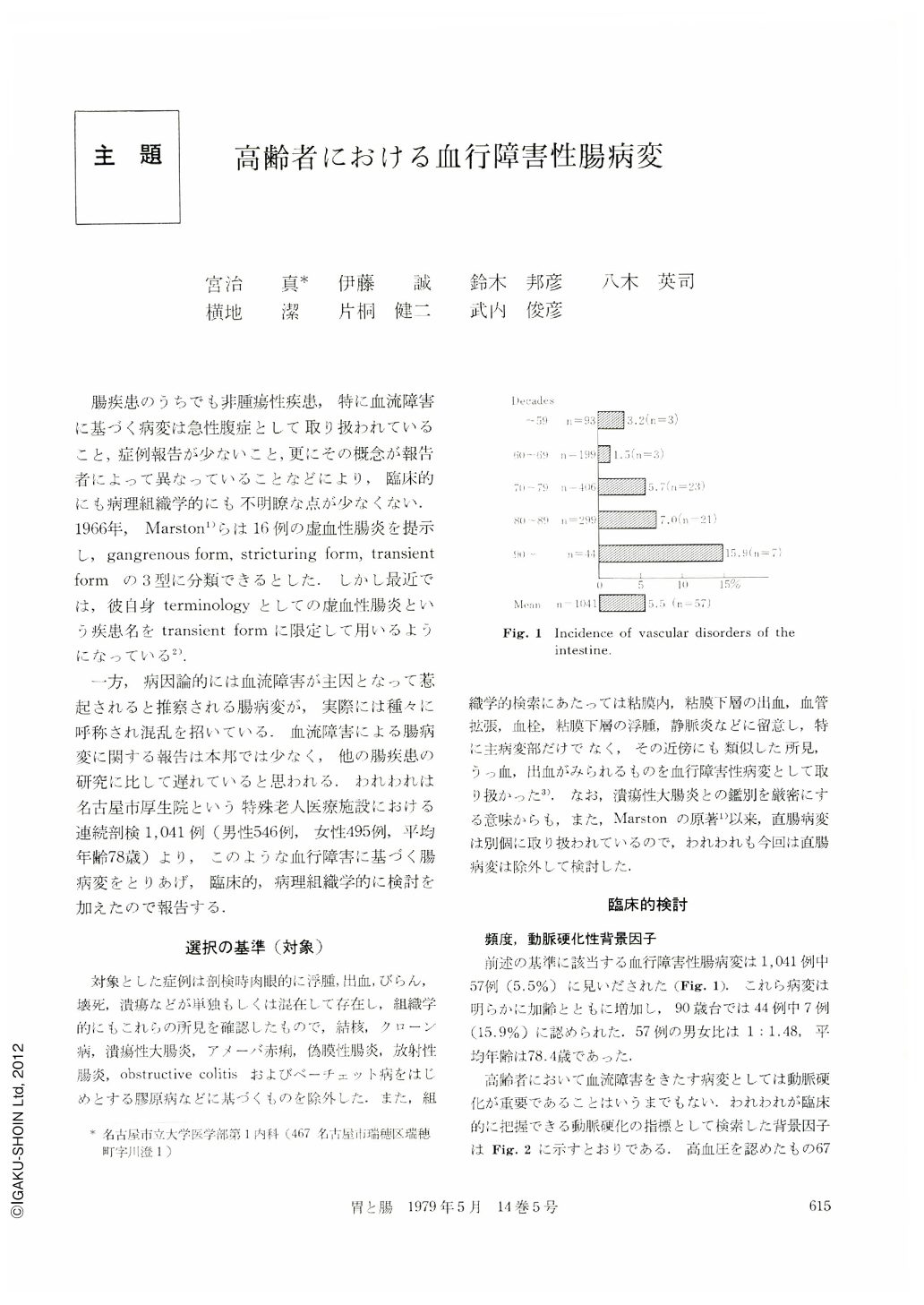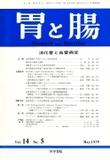Japanese
English
- 有料閲覧
- Abstract 文献概要
- 1ページ目 Look Inside
- サイト内被引用 Cited by
腸疾患のうちでも非腫瘍性疾患,特に血流障害に基づく病変は急性腹症として取り扱われていること,症例報告が少ないこと,更にその概念が報告者によって異なっていることなどにより,臨床的にも病理組織学的にも不明瞭な点が少なくない.1966年,Marston1)らは16例の虚血性腸炎を提示し,gangrenous form,stricturing form,transient formの3型に分類できるとした.しかし最近では,彼自身terminologyとしての虚血性腸炎という疾患名をtransient formに限定して用いるようになっている2).
一方,病因論的には血流障害が主因となって惹起されると推察される腸病変が,実際には種々に呼称され混乱を招いている.血流障害による腸病変に関する報告は本邦では少なく,他の腸疾患の研究に比して遅れていると思われる.われわれは名古屋市厚生院という特殊老人医療施設における連続剖検1,041例(男性546例,女性495例,平均年齢78歳)より,このような血行障害に基づく腸病変をとりあげ,臨床的,病理組織学的に検討を加えたので報告する.
For the presence of vascular disorders of the intestine were examined 1,041 autopsied cases-546 men and 495 women-whose average age was 78. Histopathological findings consistent with vascular disorders of the intestine were found in 57 cases-23 men and 34 women.
As a background of these diseases about 50 per cent of the patients had shown clinically detectable signs of arteriosclerosis such as hypertension, ischemic ST, T changes in the ECG or cerebrovascular attacks. Symptoms recognized were anorexia (43%), abdominal pain (44%), severe constipation (43%), tarry stool (32%), diarrhea (21%), defecation of a large amount of stool (7%) and shock (7%).
In this context, we observed that the plain abdominal films before the onset of symptoms showed predominant gas and feces. For the occurrence of symptoms some triggers seemed required, which were presumably extreme hypotension due to administration of anti-hypertensive drugs (53%), severe constipation (30%), infections (28%), and overturnings, fractures and contusions (16%).
Among them constipation was considered an important factor for the occurrence, so that we studied by X-ray the passing time for the excretion of barium taken orally. A reduction of activity of daily life (ADL) was related with the delay in excreting contents of the gut. The score 0 of ADL means incapability of walking by oneself and the scores 2~3 mean hobbling with a stick or wheeling by oneself. These observations were supported by a large amount of gas and feces existing before the onset of symptoms. Constipation, brought about clinically by the delay in excreting, would increase the intraluminal pressure easily and finally this increase would pave a way for the occurrence of abdominal ischaemia.
On the other hand, histological changes of the abdominal aorta in the vascular disorders of the intestine showed calcifications (53%), atherosclerotic ulcers (23%), thrombosis (48%) and aneurysms (7%).
As compared with abdominal aorta, artreriosclerosis of the bowel wall was by far slight. In addition, arteries of the serosa showed relatively high degree of arteriosclerosis in comparison with those of the mucosa. According to the fashion of the damage in vessels, vascular disorders were divided into four types: large artery occlusion (12%), minute vessel occlusion (19%), non-occlusive ischemia (67%) and venous occlusion (1%). On the other hand, histopathologic appearances of the intestinal wall could be divided into three forms: edema and erosion (19%), ulcerations (12%) and hemorrhage and necrosis (68%).
Observations described above indicated that, taken together with the sclerotic changes of arteries in the aged, there was chronic state of low flow.
Occlusions of the minute vessels were associated with disseminated intravascular coagulation (DIC). It is suggested that appearance of edema and erosion a could shift to the transient form of intestinal ischaemia, as could ulcerations to the stricturing form, only when fibrosis occurred, as likewise could hemorrhage and necrosis to the gangrenous form.
The incidence of vascular disorders of the intestine increased with advancing age. In the aged, non-occlusive ischemia and occlusion of minute vessels connected with DIC appeared to be of particular importance, as did hemorrhage and necrosis representing histopathological findings of the bowel wall.
Finally, it is considered that the triggers such as excessive hypotension due to administration of antihypertensive drugs, severe constipation, infections, and overturnings, fractures and contusions could play an important role for the occurrence of vascular disorders of the intestine in the aged.

Copyright © 1979, Igaku-Shoin Ltd. All rights reserved.


